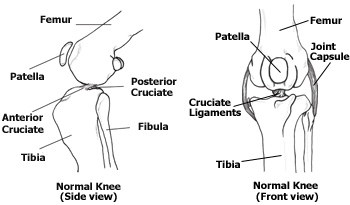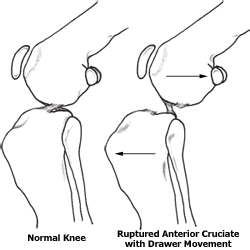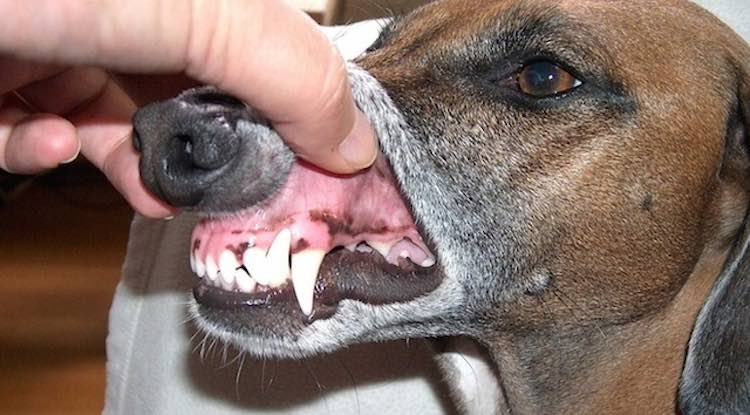Anterior Cruciate Ligament (ACL) Injuries in Dogs: Symptoms and Diagnosis
Anterior Cruciate Ligament (ACL) injuries are one of the most common orthopedic injuries veterinarians see in dogs.
The ligament is also known as the Cranial Cruciate Ligament (CCL) in animals. It connects the bone above the knee (the femur) with the bone below the knee (the tibia). Essentially, the ACL stabilizes the knee (or stifle) joint.

It does not matter the size, breed, sex or age of the dog, all dogs can get an ACL injury.
That said, studies have shows certain breeds are more prone to ACL injuries. These include: Labrador Retrievers, Poodles, Golden Retrievers, Bichon Frises, German Shepherd Dogs, and Rottweilers.
Other predispositions to ACL injury include:
- Dogs who are overweight
- Unfit dogs who engage in sudden strenuous, irregular activity (e.g. weekend warriors)
- Male dogs neutered under five months old
- Dogs with conformational abnormalities (e.g. lacking muscle tone and proper musculoskeletal development in their rear legs)
- Approximately 30-40% of dogs who get one cranial cruciate ligament rupture will likely rupture the ligament in the opposite leg within two years of the first rupture.
An ACL injury is extremely painful and affected dogs experience pain while simply walking. A tear or rupture leads to joint swelling, pain and instability in the knee joint. If left untreated it will cause lameness in the affected rear leg and, ultimately, chronic irreversible degenerative joint changes. Damage to the ACL is a major cause of progressive osteoarthritis in the knee joint of dogs.
The good news is that there is a high success rate with surgeries performed to repair ACL injuries and that dogs who receive surgical treatment can resume regular activities after rehabilitation.
Causes
ACL injuries can be caused by many factors, although the exact reasons as to why it is so common in dogs is not completely understood. Continual biomechanical wear and tear eventually causes the ACL to break down until it reaches a point that the ligament tears completely.
Simple activities such as walking, running and jumping, all cause wear and tear. Obesity, traumatic injuries or strenuous or repetitive activities can also cause the ACL to deteriorate.
ACL injuries in dogs do not always occur during athletic activities. Some dogs will be making a simple movement like jumping off a couch or going down a stair when their ACL will tear or rupture.
Most acute (sudden) ACL injuries in dogs occur during strenuous or exuberant activities, such as playing, chasing, roughhousing, running, hunting, jumping or engaging in other “doggie” fun.
Sometimes a dog will simply stumble and when they get up they will have ruptured their ACL. Other times ACL injuries will develop slowly over time. This can be caused by genetic abnormalities that cause poor muscle tone or poor neuromuscular coordination. Obesity also contributes to chronic ligament damage because of the extra weight placed on the joints.
Prevention
There is no straightforward way to prevent ACL injuries in dogs. Keeping your dog healthy and in good physical condition is the best prevention, but by no means guarantees your dog will avoid tearing their ACL.
Well-conditioned dogs are better able to avoid injuries, because their joints and bones are protected from outside stressors by strong surrounding musculature. General rules of thumb are:
- Keep dogs on high-quality diets at optimal weight
- Give dogs regular, moderate exercise.
- Dogs with conformational abnormalities in their rear legs may predispose them to ACL injuries. These dogs should not be bred and their activities monitored.
- If a dog is inactive for a period of time, avoid suddenly getting dog to do sudden strenuous activity. (e.g. if they dog has been a couch potato all winter, avoid suddenly going out for a 2 hour play time at the beach in the summer). Instead, gradually work up /train your dog to have the endurance and muscles so they can enjoy more vigorous activities.
Symptoms
Often symptoms of ACL injuries are gradual and a dog will slowly become more lame as the ligament becomes more damaged. Other times, when there is a rupture or tear, there is no advanced warning signs.
Nearly all dogs with tearing or damage to their cruciate ligament will have swelling that is felt on the front part of their knee.
Symptoms may include:
- Lameness or weakness in one or both hind legs
- Limping or reluctance to use one or both hind legs
- Limping worsens with exercise and improves with rest
- Abnormal posture, especially over the back and hip areas
- Reluctance to get up, jump, run or go up and down stairs
- Stiffness and difficulty getting up in morning
- Sitting at an odd angle, with a hind leg slanted unusually off to one side
- Swelling around the knee joint
- Muscle atrophy in the affected limb
Diagnosis
Veterinarians use a test called the cranial drawer test to check the cranial cruciate ligament for looseness. The test is called a drawer test because the movement of the femur in relation to the tibia is similar to pulling and pushing in the drawer of a cabinet. The affected knee is tested for palpable laxity or looseness, which is referred to as cranial drawer instability.


Secondarily, a radiograph (X-ray) will be taken to determine the extent of the ACL damage and the progression of the injury. X-rays also will likely reveal if there is any fluid or arthritis in the joint or if there are bone spurs or fragments.
Partial ruptures are more difficult to diagnose. Dogs with partial ligament tears will usually have swelling of their knee and pain when their knee is completely extended.
The video below summarizes symptoms and diagnosis of ACL injuries.






